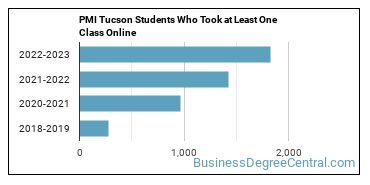Pima Medical Institute - Tucson Business Programs
Located in Tucson, Arizona, Pima Medical Institute - Tucson is a private for-profit institution. The location of the school is great for students who enjoy the amenities of city life.
Featured schools near , edit
Where Is Pima Medical Institute - Tucson?

Contact details for PMI Tucson are given below.
| Contact Details | |
|---|---|
| Address: | 2121 N Craycroft Road, Bldg 1, Tucson, AZ 85712 |
| Phone: | 520-326-1600 |
| Website: | pmi.edu |
Can I Afford Pima Medical Institute - Tucson?
Student Loan Debt
Almost 66% of college students who graduated with the class of 2018 took out student loans, but that percentage varies from school to school. At PMI Tucson, approximately 77% of students took out student loans averaging $7,889 a year. That adds up to $31,556 over four years for those students.
Pima Medical Institute - Tucson Undergraduate Student Diversity
Gender Diversity
Of the 2,485 full-time undergraduates at PMI Tucson, 18% are male and 82% are female.

Racial-Ethnic Diversity
The racial-ethnic breakdown of Pima Medical Institute - Tucson students is as follows.

| Race/Ethnicity | Number of Grads |
|---|---|
| Asian | 125 |
| Black or African American | 214 |
| Hispanic or Latino | 972 |
| White | 873 |
| International Students | 3 |
| Other Races/Ethnicities | 298 |
Geographic Diversity
Arizona students aren't the only ones who study at Pima Medical Institute - Tucson. At this time, 28 states are represented by the student population at the school.
Over 10 countries are represented at PMI Tucson. The most popular countries sending students to the school are Japan, Philippines, and Malaysia.
Online Learning at Pima Medical Institute - Tucson
The following chart shows how the online learning population at PMI Tucson has changed over the last few years.

This school is the 25th most popular in Arizona for online learning according to the online graduations recorded by the Department of Education for the academic year 2022-2023.
References
*The racial-ethnic minorities count is calculated by taking the total number of students and subtracting white students, international students, and students whose race/ethnicity was unknown. This number is then divided by the total number of students at the school to obtain the racial-ethnic minorities percentage.
More about our data sources and methodologies.
Featured Schools
You have goals. Southern New Hampshire University can help you get there. Whether you need a bachelor's degree to get into a career or want a master's degree to move up in your current career, SNHU has an online program for you. Find your degree from over 200 online programs.
Visit School
